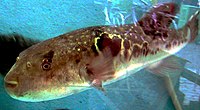
Photo from wikipedia
Abstract Pufferfish may be responsible for human intoxications due to the accumulation of a potentially lethal neurotoxin, called tetrodotoxin (TTX). While traditionally some species of pufferfish are consumed in Japan,… Click to show full abstract
Abstract Pufferfish may be responsible for human intoxications due to the accumulation of a potentially lethal neurotoxin, called tetrodotoxin (TTX). While traditionally some species of pufferfish are consumed in Japan, their marketing is banned in the EU. However, their illegal presence in mislabelled products has been reported. Moreover, some species of the genus Lagocephalus spread in the Mediterranean Sea during the last decades due to the Lessepsian migration phenomenon and they may represent a significant emerging risk within the European seafood chain. This study aimed at finding a suitable molecular marker for quickly identifying Lagocephalus species in fresh and processed products. All available sequences of COI and cytb mitochondrial genes were used to create different length datasets (long and short fragments) to be used to produce NJ trees depicting genetic relationships for Lagocephalus spp. On the basis of its higher variability, cytb gene was selected as the molecular target and 17 new complete sequences of 6 Lagocephalus species, deriving from reference samples, were produced and included in the datasets. Then, a primer pair for amplifying a 130bp cytb polymorphic fragment from all of the Lagocephalus spp. was designed for identifying sixteen mislabelled commercial products containing pufferfish with degraded DNA. Cytb dataset's phylogenetic analysis supported the most recent species classification of the Lagocephalus genus and highlighted the presence of toxic L. spadiceus in the products. The analysis of the proposed short fragment could represent a reliable tool to protect European consumers from the emerging risk associated to toxic Lagocephalus spp.
Journal Title: Food Control
Year Published: 2018
Link to full text (if available)
Share on Social Media: Sign Up to like & get
recommendations!